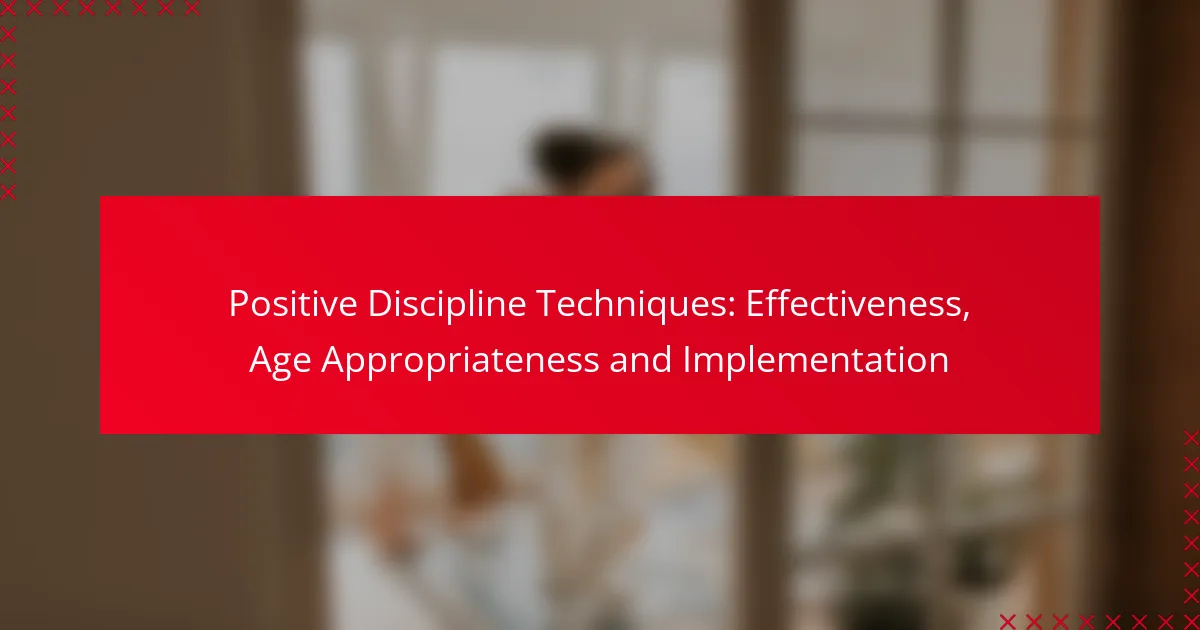Positive discipline techniques emphasize guiding children’s behavior through supportive and constructive methods rather than punishment, fostering self-discipline and respect. Tailored to fit various developmental stages, these strategies enhance the effectiveness of discipline across age groups. By focusing on teaching rather than punishing, positive discipline cultivates a respectful environment that encourages children to learn from their mistakes and build healthier relationships.
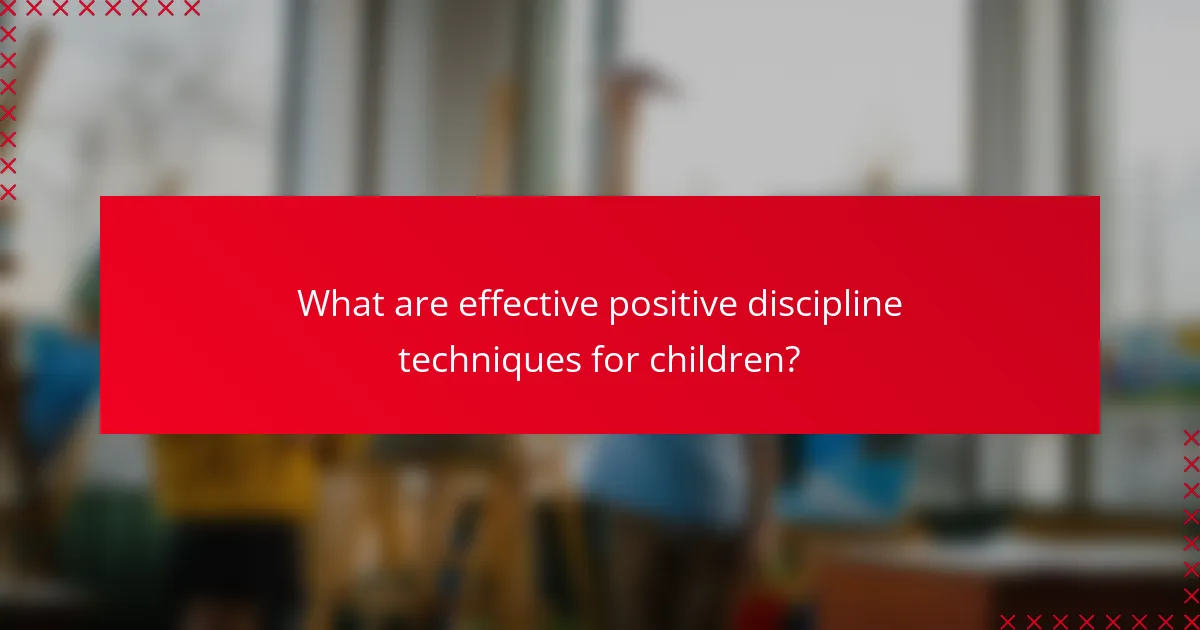
What are effective positive discipline techniques for children?
Effective positive discipline techniques focus on guiding children’s behavior through supportive and constructive methods rather than punishment. These techniques foster a child’s self-discipline, responsibility, and respect for others while maintaining a positive relationship between the child and caregiver.
Positive reinforcement
Positive reinforcement involves acknowledging and rewarding desirable behaviors to encourage their recurrence. This can be done through verbal praise, stickers, or small rewards when a child demonstrates good behavior. For example, if a child completes their homework on time, offering praise or a fun activity can motivate them to continue this behavior.
To implement positive reinforcement effectively, be specific about what behavior you are praising. Instead of saying “good job,” you might say, “I really appreciate how you helped your sister with her homework.” This clarity reinforces the exact behavior you want to see more often.
Time-out strategies
Time-out strategies involve temporarily removing a child from a situation to help them calm down and reflect on their behavior. This technique is most effective for younger children, typically between the ages of 2 and 7, and should last about one minute for each year of the child’s age.
When using time-outs, choose a designated quiet space free from distractions. Explain to the child why they are in time-out and what behavior needs to change. After the time-out, discuss the incident and encourage the child to express their feelings and thoughts.
Natural consequences
Natural consequences occur when children experience the direct results of their actions, helping them learn responsibility. For instance, if a child refuses to wear a coat on a chilly day, they will feel cold, which teaches them to dress appropriately in the future.
While natural consequences can be effective, ensure that they are safe and appropriate. Avoid situations where the consequences could lead to harm or significant distress. Instead, guide the child through the experience, discussing what happened and what they could do differently next time.
Collaborative problem-solving
Collaborative problem-solving involves working together with the child to find solutions to behavioral issues. This technique encourages children to express their feelings and thoughts while promoting critical thinking and negotiation skills. For example, if a child struggles with sharing toys, you can discuss why sharing is important and brainstorm ways to take turns.
To implement this strategy, create a safe space for open dialogue. Ask questions that encourage the child to think about their behavior and its impact on others. This approach fosters a sense of ownership and responsibility for their actions.
Modeling appropriate behavior
Modeling appropriate behavior means demonstrating the actions and attitudes you wish to see in your child. Children learn significantly through observation, so displaying kindness, patience, and respect in your interactions sets a powerful example. For instance, if you handle frustration calmly, your child is more likely to mimic that behavior.
To effectively model behavior, be mindful of your actions and words in everyday situations. Engage in discussions about emotions and appropriate responses, reinforcing the lessons through real-life examples. This practice not only teaches children but also strengthens your relationship with them.

How age-appropriate are positive discipline techniques?
Positive discipline techniques can be tailored to fit the developmental stages of children, making them effective across various age groups. Understanding the specific needs and behaviors of each age range helps in implementing these strategies successfully.
Infants and toddlers
For infants and toddlers, positive discipline focuses on establishing a secure environment and fostering attachment. Techniques such as gentle redirection and consistent routines help guide behavior without harshness. At this stage, caregivers should prioritize understanding cues and responding to needs, as infants cannot yet comprehend complex rules.
Examples include using distraction to shift attention from undesirable behavior or offering choices to empower toddlers. Consistency is key, as it builds trust and a sense of safety.
Preschoolers
Preschoolers benefit from positive discipline through clear expectations and simple explanations. At this age, children are beginning to understand the concept of rules and consequences. Techniques such as time-outs and reward systems can be effective, provided they are age-appropriate and not overly punitive.
For instance, using a sticker chart to reward good behavior can motivate preschoolers. It’s essential to communicate clearly and reinforce positive actions regularly, helping them learn self-regulation.
School-age children
School-age children can handle more complex discussions about behavior and consequences. Positive discipline at this stage involves teaching problem-solving skills and encouraging responsibility. Techniques like setting family rules together or involving children in decision-making can foster a sense of ownership.
For example, if a child misbehaves, discussing the impact of their actions and collaboratively finding solutions can be effective. Parents should also model appropriate behavior, as children learn by observing adults.
Adolescents
With adolescents, positive discipline shifts towards fostering independence while maintaining guidance. This age group requires respect and understanding, as they are developing their identities. Techniques such as open communication and negotiation can help address conflicts and encourage responsible decision-making.
For instance, involving teens in discussions about household rules can promote cooperation. It’s important to listen actively to their perspectives and validate their feelings, which can strengthen the parent-child relationship during these formative years.
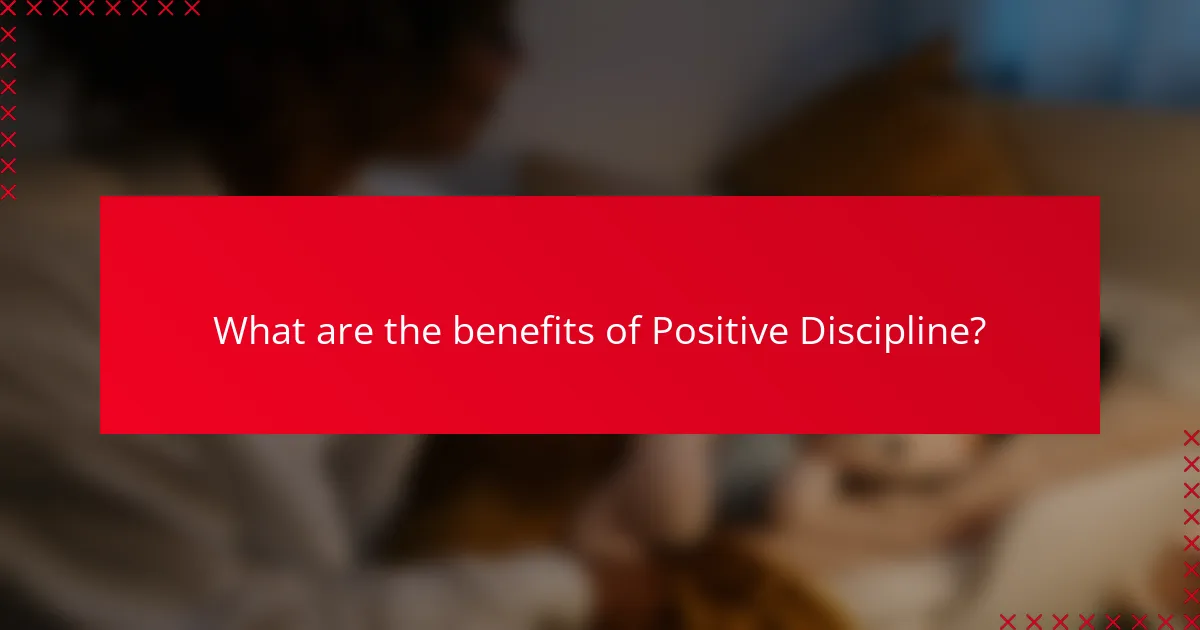
What are the benefits of positive discipline?
Positive discipline offers numerous benefits, including fostering a respectful environment that encourages children to learn from their mistakes. This approach emphasizes teaching rather than punishing, leading to long-term behavioral improvements and healthier relationships.
Improved behavior
Positive discipline techniques promote improved behavior by encouraging children to understand the consequences of their actions. Instead of using punitive measures, parents can implement strategies like setting clear expectations and providing consistent feedback. For example, using time-outs or logical consequences can help children connect their behavior with outcomes, leading to better decision-making in the future.
Additionally, positive discipline focuses on reinforcing good behavior through praise and rewards, which can motivate children to repeat those behaviors. This method often results in a more harmonious home environment where children feel secure and understood.
Stronger parent-child relationships
Implementing positive discipline can significantly strengthen parent-child relationships by fostering open communication and mutual respect. When parents approach discipline with empathy and understanding, children are more likely to feel valued and heard. This can lead to a deeper emotional connection and trust between parents and their children.
Moreover, positive discipline encourages parents to engage in problem-solving discussions with their children, which can enhance their relationship. For instance, involving children in setting rules or consequences helps them feel a sense of ownership and responsibility, further solidifying their bond.
Enhanced emotional regulation
Positive discipline supports enhanced emotional regulation in children by teaching them how to manage their feelings effectively. By modeling appropriate responses to frustration or disappointment, parents can guide their children in developing coping strategies. Techniques such as deep breathing or taking a break can be introduced as tools for self-regulation.
Furthermore, this approach encourages children to express their emotions in constructive ways. Parents can help by validating their feelings and discussing appropriate ways to handle them, which can lead to improved emotional intelligence and resilience over time.
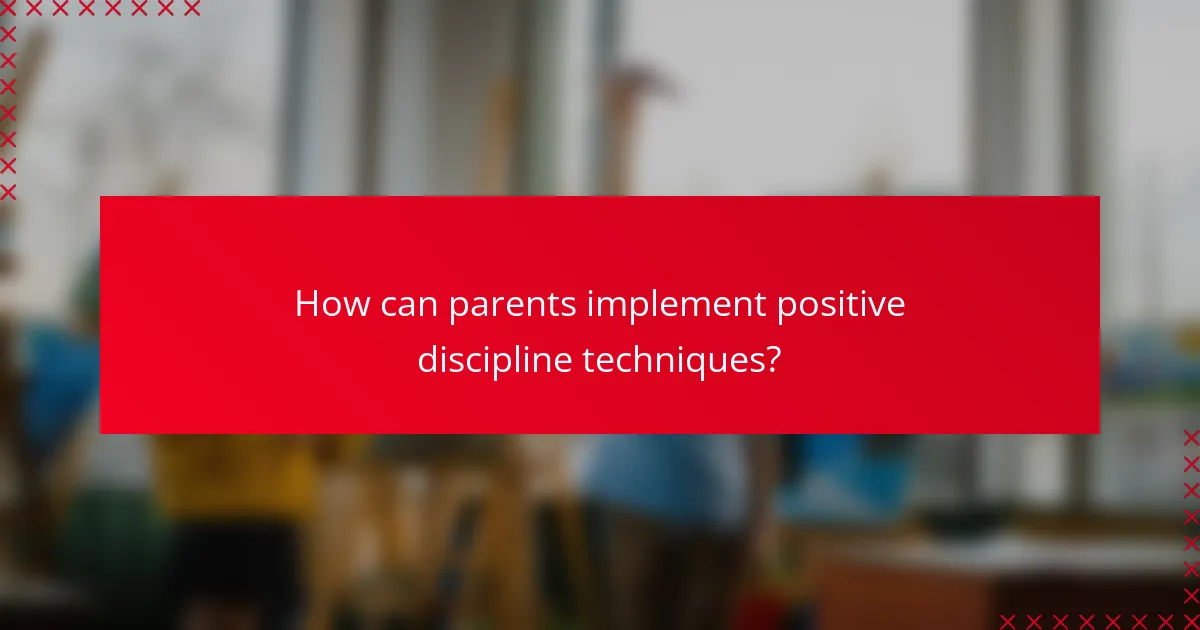
How can parents implement positive discipline techniques?
Parents can implement positive discipline techniques by establishing clear guidelines, maintaining consistency, and fostering open communication. These strategies help children understand expectations and the consequences of their actions, promoting a respectful and cooperative environment.
Setting clear expectations
Setting clear expectations involves defining specific behaviors that are acceptable and those that are not. Parents should communicate these expectations in simple, age-appropriate language, ensuring that children understand what is required of them. For example, instead of saying “be good,” specify “please put your toys away after playing.”
Visual aids, such as charts or lists, can reinforce these expectations. For younger children, using pictures alongside words can enhance understanding and retention.
Consistent follow-through
Consistency in applying rules and consequences is crucial for effective discipline. When parents consistently enforce expectations, children learn that their actions have predictable outcomes. For instance, if a child knows that not completing homework results in limited screen time, they are more likely to prioritize their tasks.
It’s important for parents to agree on rules and consequences to avoid confusion. If one parent allows a behavior while the other does not, it can undermine the discipline strategy.
Effective communication
Effective communication is key to positive discipline. Parents should engage in regular discussions with their children about feelings, expectations, and behaviors. This dialogue helps children feel heard and valued, making them more receptive to guidance.
Using “I” statements can facilitate better understanding. For example, saying “I feel upset when you don’t listen” instead of “You never listen” can reduce defensiveness and encourage cooperation.
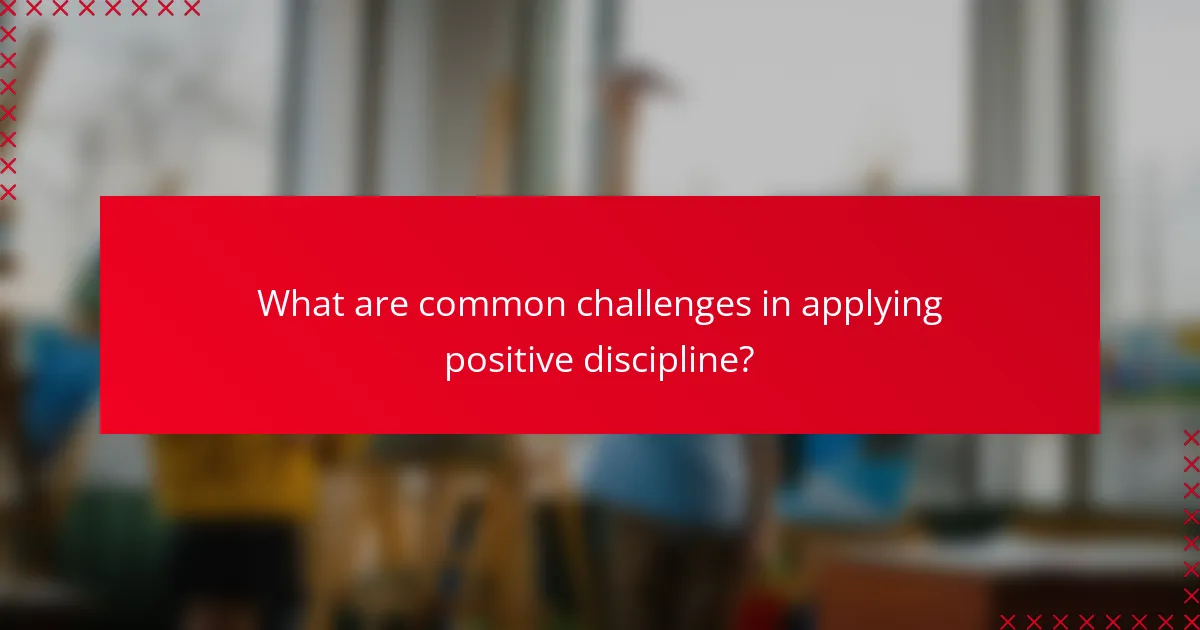
What are common challenges in applying positive discipline?
Applying positive discipline can be challenging due to various factors that may hinder its effectiveness. Common issues include inconsistent application, lack of understanding, and difficulties in maintaining patience and empathy.
Inconsistent application
Inconsistent application of positive discipline can lead to confusion for children, making it difficult for them to understand expectations. When rules and consequences vary, children may test boundaries more frequently, undermining the discipline approach.
To ensure consistency, caregivers should establish clear guidelines and communicate them effectively. Regularly reviewing these rules and involving children in discussions about them can reinforce understanding and adherence.
Common pitfalls include reacting differently based on mood or situation. To avoid this, caregivers can create a checklist of responses to specific behaviors, ensuring a uniform approach regardless of external factors.
